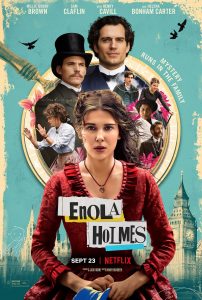‘Enola Holmes’ mooches off Sherlock Holmes legacy
October 7, 2020
“Enola Holmes,” Netflix’s newest original movie, had a good message, but it could’ve been done differently.
The movie follows a 16-year-old girl who happens to be the sister of the famous Sherlock Holmes. When her mother goes missing, her brothers Sherlock and Mycroft come home to see what they can do. But when they don’t give Enola the answers that she’s looking for, she sets off to solve it herself.
Of course, she finds a boy along the way, who she thinks is a waste of her time, but ends up caring for him while uncovering the true mystery around him.
The plot itself is interesting, and there are some unexpected twists and turns, but I don’t think that it needed to be based off of Sherlock Holmes. There are so many ways that the author of the book series, Nancy Springer, and the director, Harry Bradbeer, could’ve made it more original.

Using the Holmes name seems to be a way to get the audience to buy in that this will be a good story. I mean that’s why I watched it – I thought it might be like “Sherlock.”
The writers and director could’ve made the story during the time of Sherlock Holmes and a girl who maybe wants to be like him. They could’ve also just made it a story about a girl with a weird mother, whose normal brothers come home to help when their 16 year-old sister is left alone to fend for herself.
There are plenty of other possibilities with this film.
However, I will give credit and be lenient on the fact that this is based on a book in a series so there could be a deeper reason for relating it to Sherlock Holmes. In the movie, though, I didn’t see it other than to get you to watch the movie in the first place and then keep watching to see if Sherlock Holmes does his thing.
Another issue I had with this movie is the random characters that pop up, like a random self defense instructor and a detective that truly doesn’t do much.
Clearly I’m not the only one who had problems with this movie, because according to CinemaBlend.com there is a lawsuit claiming copyright and trademark issues from the last ten original “Sherlock Holmes” stories. The stories are owned by Conan Doyle, the author, who’s estate is suing.
Now that I’ve ripped on the movie, I do want to give credit where credit is due.
First, the name Enola is an interesting name to begin with because when you spell it backwards, it spells “alone,” and that has meaning all in itself (which would probably be easier to understand in the novels). It leads well into the idea of the mysteries of her mother, and how Enola solves some of her own mysteries. Despite this being a clever idea, Enola brings it up about every 10 minutes, which does get a bit annoying.
Speaking of Enola, Millie Bobby Brown did a bitching job (get it, “Stranger Things” reference) at playing Enola. She broke that fourth wall in a way that was compelling for viewers to want to see and made you more engaged because she was talking to you.
The other actors all did a great job of basically ignoring her while she broke it, never acknowledging it in the slightest.
The casting director, Jina Jay, made another exceptional choice by choosing Helen Bonham Carter to play the mother.
Bonham Carter kept her reputation of playing strange characters who the audience is just trying to understand. Because of this reputation she already has, it’s easy to believe that she would just leave her daughter to try and, well, I won’t say so I don’t spoil it.
The other main actors, Henry Cavill (Sherlock) and Sam Claflin (Mycroft), played their roles well as the two brothers, being mysterious and angry about everything, respectively.
Without these big-name actors, the movie wouldn’t have been able to keep our attention because Brown, Bonham Carter, Cavill and Claflin all bring a presence to their movies that makes the audience want to see what they will do next.
We also have the actor who plays Enola’s love interest, Louis Partridge, as an up-and-coming young actor who I’m sure we will see in many more young adult films. For “Enola Holmes” being Partridge’s first major role, he did an exceptional job, and I’m sure we will see him in many different young adult films.
Beyond the acting, other components such as costumes, set design and lighting did do a great job of portraying the time period (1880-1914) accurately. Downtown London takes all of these well-done elements and puts them together, making a bustling and chaotic town with proper people and the feel of the late 1880s.
The film also has a great and powerful message that we get through Enola’s journey. It is a story of female empowerment and finding oneself, especially putting yourself apart from family.
This message and the end of the movie calls for a sequel, so keep an eye out! Hopefully next time we get a more cohesive and interesting plot, but Brown and her colleagues will continue to play Enola Holmes and those around her well, no matter the plot.













